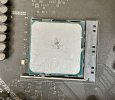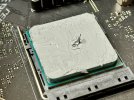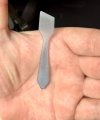I only repaste/paste a CPU once in a blue moon. Below are pics of my latest repaste application.



I got a thermal paste spreader with a tube of Arctic MX-4. I started using it first to spread out the thermal paste, and then I like to add a smidge of extra thermal paste in the center as I do not want to have too little paste on the CPU.
Did I do a good job greasing up this CPU? lol
Edit: nope. Will just stick with placing a single pea-sized dollop of thermal paste in the center. Much easier and faster and works good enough.



I got a thermal paste spreader with a tube of Arctic MX-4. I started using it first to spread out the thermal paste, and then I like to add a smidge of extra thermal paste in the center as I do not want to have too little paste on the CPU.
Did I do a good job greasing up this CPU? lol
Edit: nope. Will just stick with placing a single pea-sized dollop of thermal paste in the center. Much easier and faster and works good enough.
Last edited:



